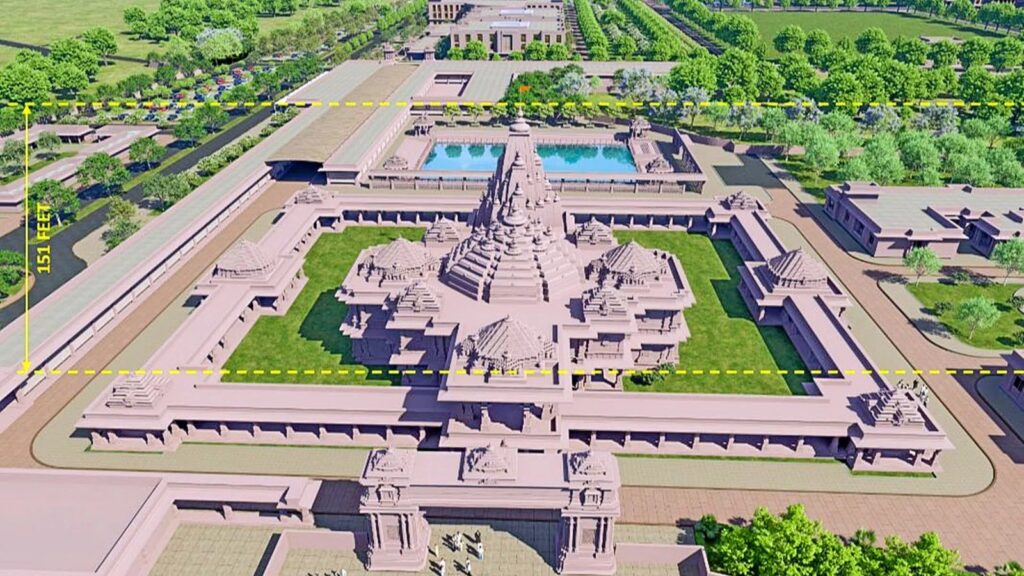Accompanied by Bihar Chief Minister and JD(U) president Nitish Kumar, Union Home Minister Amit Shah is laying the foundation stone for the re-development of the Mata Janaki temple at Punaura Dham in Sitamarhi in the Mithila region on Thursday afternoon, launching a major project at the site which is believed to be the birthplace of Goddess Sita.
The proposed revamp and renovation of the Sita temple at Punaura Dham is set to be one of the key issues of the ruling NDA in the state Assembly polls due in three months. Shah had announced this project at a “Shashwat Mithila Mahotsav 2025” event in Ahmedabad in March this year.
The project, which seeks to emulate the scale and grandeur of Ayodhya’s Ram temple, was first sanctioned in September 2023 alongside a larger project to develop religious tourism. At the time, the JD(U) and the RJD were part of the ruling Mahagathbandhan in the state.
The JD(U) switched back to the NDA in January 2024, marking a political shift that has coincided with an aggressive push on infrastructure and religious tourism projects ahead of the upcoming Assembly elections.
What is the project’s plan?
The Nitish government’s plan for Sitamarhi is in place, even as it features in the Centre’s list of 15 tourism-cum-religious places on the Ramayana Circuit, which is one of the 15 thematic circuits identified for development under the Swadesh Darshan scheme of the Union Ministry of Tourism. The projects under the scheme are identified in consultation with the state governments or Union Territory administrations.
The Bihar government’s plan includes the setting up of a parikrama path (a path to circumambulate the temple) with a roof and sandstone pillars. A Sita Vatika (Sita’s garden), Luv-Kush Vatika (Luv-Kush garden) and a shanti mandap (area for meditation) are also being planned besides a cafeteria and a parking lot. A 3-D animation film, depicting Sita’s life, is also in the pipeline.
As a part of the plan, which is aimed to be completed within 11 months, the state’s tourism department is also working to redevelop at least a dozen sites believed to be associated with Lord Ram and Sita.
Story continues below this ad
How will the project be developed?
On July 1 this year, the Nitish Cabinet sanctioned Rs 882.87 crore for the project. Of this, Rs 137 crore has been allocated for the renovation of the existing temple and its surroundings, Rs 728 crore for tourism-related infrastructure, and Rs 16 crore for a decade of comprehensive maintenance.
In another Cabinet meeting on July 29, a revised estimate of Rs 165.57 crore was also cleared for the acquisition of an additional 50 acres of land, apart from the 17 acres currently available at temple premises. The new land will be used for developing tourism infrastructure and related facilities, officials informed.
The Bihar State Tourism Development Corporation (BSTDC) will be the executing agency of the project. The state government also constituted a nine-member trust, “Shree Janaki Janm Bhumi Punaura Dham Mandir Nyas Samiti” on June 26 to oversee the construction and management of the temple.
According to officials, the Trust will be chaired by the Chief Secretary, with the Development Commissioner as its vice-chairman. The District Magistrate and Deputy Development Commissioner of Sitamarhi will serve as the Trust’s secretary and treasurer, respectively. It will also have members from the Mahanth of Punaura Dham Mutt, Divisional Commissioner of Tirhut, and officials from tourism, road construction, and urban development and housing departments. “The Trust’s bank account will be jointly operated by the secretary and treasurer,” an official said.
Story continues below this ad
What is Sitamarhi’s religious significance?
Punaura Dham is regarded by Hindus as Sita’s birthplace. Located around 5 km from Sitamarhi town, near the India-Nepal border, it holds religious significance for pilgrims from Bihar and other states.
The project is being developed as part of the Ramayana circuit, a broader initiative linking Ayodhya, Sitamarhi, and Janakpur in Nepal, to boost religious tourism and pilgrimage routes.
How has Hindutva impacted Bihar politics?
Due to its long association with socialist politics, Hindutva has not been a decisive factor in the Bihar elections. After the demolition of the Babri Masjid in 1992, the BJP fared poorly in the subsequent elections. In the 1995 Assembly elections, the party managed to get only 41 of the 324 (undivided Bihar) seats. The BJP has also not been able to dominate electorally when it has contested alone. In the 2015 elections, despite the Narendra Modi wave, the party managed to win only 91 of the 243 seats.
This is also not the first time that a political party or coalition has tried to focus on Sita.
Story continues below this ad
During his Bharat Jodo Yatra, Congress leader Rahul Gandhi said at a public meeting, “Yeh (RSS) ‘Jai Siya Ram’ kabhi nahi kehte. Inhone Sita ji ko naare se nikaal diya… Yeh hamare itihaas ke khilaaf kaam kiya inhone (The RSS workers never say ‘Jai Siya Ram’. They have removed Sita from the salutation. This is something that is against our history). I am telling you (Congress workers), every time you come across an RSS worker, ask them to say ‘Jai Siya Ram’. Kyunki, jitne jaroori Ram the, utni jaroori hi Sita ji thi (because Sita is as significant as Ram).”


